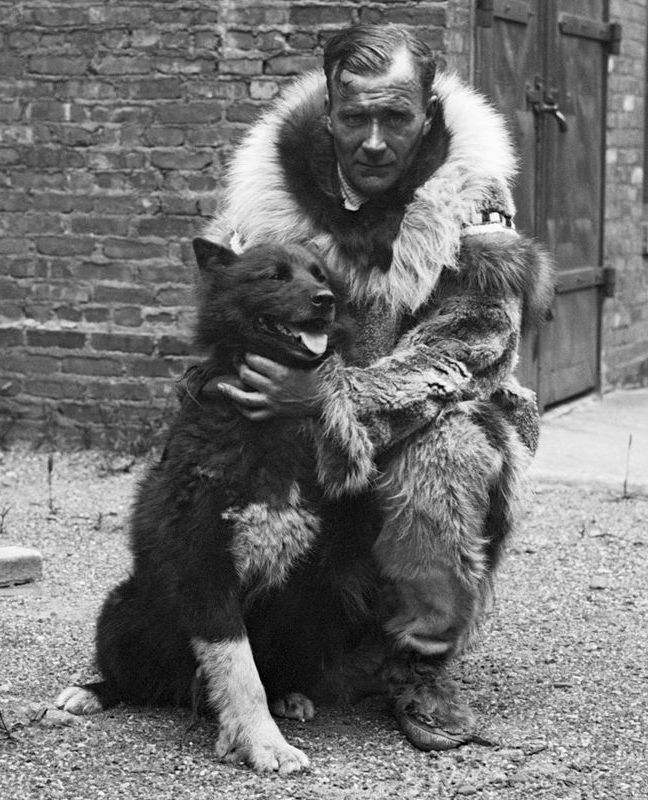
They say dogs are a man’s best friend – but did you know they’ve also changed the course of history?
To celebrate #InternationalDogDay, here are 9 amazing dogs you need to know about.
A Goodable thread.
To celebrate #InternationalDogDay, here are 9 amazing dogs you need to know about.
A Goodable thread.

During WWI, a stray dog became the unofficial mascot of the 102nd Infantry Division.
He served alongside the soldiers, alerting them to incoming artillery and deadly gas, and even comforting wounded soldiers.
Tubby is the only dog to be promoted to Sergeant through combat.
He served alongside the soldiers, alerting them to incoming artillery and deadly gas, and even comforting wounded soldiers.
Tubby is the only dog to be promoted to Sergeant through combat.

In 1925, the town of Nome, Alaska experienced a deadly diphtheria outbreak.
With an incredibly harsh winter, dogsledding was the only way to get there.
Balto the sled dog led a team of 150 dogs and 20 men to transport the antitoxin to Nome, saving the town from the outbreak.
With an incredibly harsh winter, dogsledding was the only way to get there.
Balto the sled dog led a team of 150 dogs and 20 men to transport the antitoxin to Nome, saving the town from the outbreak.

When he was 16, Morris Frank lost his eyesight.
Four years later, he heard about special dogs who were helping veterans who had lost their eyesight in Germany.
He wrote to a dog trainer, who arranged for him to get one of his own.
Buddy became America’s first seeing eye dog.
Four years later, he heard about special dogs who were helping veterans who had lost their eyesight in Germany.
He wrote to a dog trainer, who arranged for him to get one of his own.
Buddy became America’s first seeing eye dog.

This is Salty and Roselle, two guide dogs.
When the attack on the twin towers happened in 2001, they helped guide their owners down more than 70 floors to safety, getting them out just in time.
They were later awarded a medal for their bravery and heroism.
When the attack on the twin towers happened in 2001, they helped guide their owners down more than 70 floors to safety, getting them out just in time.
They were later awarded a medal for their bravery and heroism.

During WWII, a group of American soldiers found Smoky the Yorkshire Terrier abandoned in a foxhole.
Her small size helped soldiers set up communication lines during air raids.
Her intelligence saved more than 300 lives.
Her small size helped soldiers set up communication lines during air raids.
Her intelligence saved more than 300 lives.

St Bernards are some of the most adorable dogs around, but did you know they have a long history of being rescue dogs?
They were originally bred to rescue people from the St Bernard Pass in Switzerland, and have helped find more than 2,000 people in the pass after snowstorms.
They were originally bred to rescue people from the St Bernard Pass in Switzerland, and have helped find more than 2,000 people in the pass after snowstorms.

In the 1930’s, a local retriever lived by the docks in Swansea and had a natural instinct for saving lives.
As a puppy, Swansea Jack saved a 12-year-old boy from drowning.
He went on to save 27 people over the course of his life.
As a puppy, Swansea Jack saved a 12-year-old boy from drowning.
He went on to save 27 people over the course of his life.

In 1940, a group of boys were walking a dog when the dog noticed a bunny and chased after it.
While following the dog, they discovered the Lascaux caves.
The caves contained never before seen prehistoric art, and changed science’s understanding of prehistoric culture.

While following the dog, they discovered the Lascaux caves.
The caves contained never before seen prehistoric art, and changed science’s understanding of prehistoric culture.


The President of Ireland, Michael D Higgins, has a dog who accompanies him everywhere.
He has no idea how important his owner is, and doesn’t care.
He’s even been known to enter official events looking for belly rubs from the President.
He has no idea how important his owner is, and doesn’t care.
He’s even been known to enter official events looking for belly rubs from the President.
There are just some examples of wonderful, heroic dogs. There are countless others throughout history, of dogs who sacrificed everyone to keep their owns safe and secure.
Happy International Dog Day!
Happy International Dog Day!
• • •
Missing some Tweet in this thread? You can try to
force a refresh




















